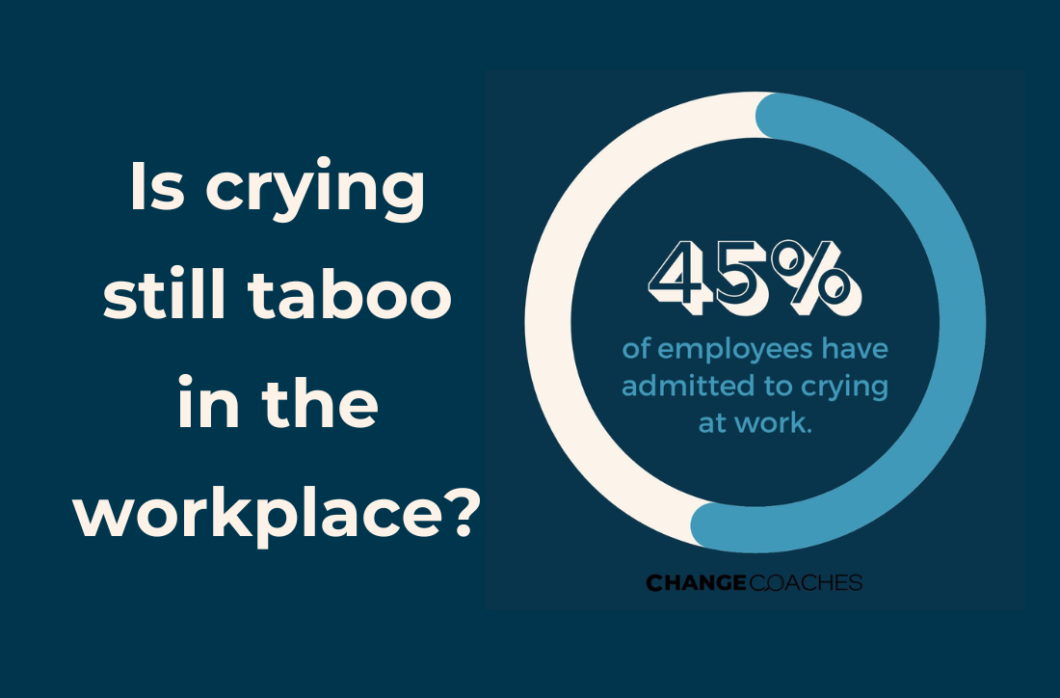Have you ever cried at work?
Have you ever witnessed someone else crying at work?
How did you respond?
Crying in the workplace might feel like the ultimate taboo, but it’s much more common than we think.
If you have ever cried at work, you’re in good company, because 45% of professionals have reported crying in the workplace. Stress, anger, frustration, fear, and overwhelm are all common emotions that lead to crying at work – we don’t always cry because we’re feeling sad.
While many fear that crying at work may make them look unprofessional to leadership, that could be changing. A recent survey of more than 2,000 C-suite executives revealed that 44% of CFOs say that an occasional workplace cry is acceptable, and 30% of C-suite leaders believe crying at work has no negative impact on your reputation at all.
Of course, on the flip side, that means that 70% of C-suite leaders DO believe that crying at work can damage your reputation – so there’s clearly still a lot of change that needs to occur before it becomes truly acceptable to cry at work (even though nearly half of professionals report needing to have a workplace cry from time to time).
Since March is Women’s History Month, I feel compelled to bring up the fact that for women in particular, crying in the workplace is extremely loaded. In general, women cry on average 5.3 times per month, versus 1.3 times per month for men. Bustle, Stylist, and Women’s Day have all recently run articles on how to keep oneself from crying at work, because research shows that when women cry at work, they are more likely to be perceived as unprofessional, weak, or manipulative than their colleagues. This is doubly true for women of color, who have to work against racism in the workplace in addition to sexism.
Yet many experts say that crying can actually be a sign of strength – crying helps us regulate our emotions, which is much more mentally healthy than bottling those feelings up. When people express emotion in a supportive environment, it can often bring them closer together. One of the reasons people tend to feel so guilty for crying at work is because that support isn’t present, which can lead to feelings of shame and embarrassment.
Crying at work is extremely common and can have important mental health benefits — so it is clear that leaders shouldn’t work to discourage it. In a psychologically safe workplace, employees should be able to trust that the occasional workplace cry won’t damage their career, especially the employees who already have the deck stacked against them because of their gender or race.
An empathetic, below the surface leader will understand this and work to support employees. Research has shown that workers need emotional communication and compassion from their leaders in all aspects of their work. When employees believe their leaders are empathetic and compassionate, their productivity increases, and they are less likely to leave their position. Sadly, even though there is plenty of empirical evidence to support the argument that empathetic leadership is the way to go, the dominant workplace standard is often completely the opposite. Case-in-point: I was once asked to do a keynote on empathy and couldn’t help but notice how often one of the leaders in the room profusely rolled his eyes. I’m sure he was among the 70% of leaders who believe crying at work is always damaging.
In a landscape where the dominant leadership standard is so at-odds with the research, it is even more important to lead below the surface. Not only will this help you maintain the best relationship with your employees, but it gives you a distinct advantage over other leaders who refuse to embrace empathy.
Next time you encounter a colleague or employee crying in the workplace, these are some concrete things you can do to stay below the surface:
- Don’t try to shut it down. Instead, ask the person open-ended questions, like: “What can I do to support you right now?”
- Sit with your discomfort. Crying makes everyone uncomfortable — this is one of the many reasons why it is so taboo to cry at work. It can be tempting to try to make the discomfort go away, but this is often unhelpful and can make the crying person feel judged.
- Remember that most emotion at work stems from frustration, not sadness. This can be an important thing for leaders and managers to pay attention to, especially if the root cause of the frustration is something that can be addressed within the company.
- Sometimes a momentary cry is just that: a moment to regain control of one’s emotions. But depending on the context of the cry, the employee may require additional emotional support. If it feels appropriate, you can suggest that the employee take a mental health or wellness day.

